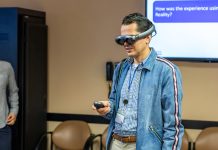
Virtual reality (VR) presents an exciting opportunity for training and onboarding. Simulations on these platforms are inherently immersive, providing a compelling new way to walk employees through real-world situations without needing a real environment.
For all its benefits, though, VR can be challenging to master. Managers hoping to use this technology to its fullest should follow a few best practices to ensure effective and engaging training.
1. Make Sure VR Serves a Purpose
The first step to impactful VR learning is ensuring that it’s the right solution for the company’s training goals. Technology must always be a solution to an existing problem. A lack of alignment or clarity on business outcomes is the most common reason behind delays in tech projects, so it’s essential not to use VR merely for VR’s sake.
Ask why VR is the ideal platform for a learning experience. Generally speaking, it’s best when employees need firsthand experience but real-world situations would be disruptive or hazardous. It may not be necessary if on-the-job guidance is easy and safe.
2. Set Clear Objectives
Similarly, managers must set specific goals for what the VR training will achieve. It’s easier to develop a relevant and realistic virtual experience once the team understands what skills users should gain from it.
Setting objectives keeps VR development on track and improves the overall lesson effectiveness. Adults learn best from real problem-oriented concepts, so management should base virtual scenarios on actual situations or issues they’ll encounter. Remember to set goals for the learning outcomes and how the VR solution compares to the training method it replaces.
3. Determine the Ideal Level of Interactivity
When building the VR experience, teams should consider how interactive the environments will be. More interactivity generally promotes higher engagement and better learning, but limits may exist.
Too many interactive elements may be distracting. Excessive physics modeling could also raise development costs and timelines, pushing projects beyond their budgets. Strike a balance by providing multiple interaction points in the training itself but keeping interactivity that wouldn’t serve a relevant purpose to a minimum.
4. Build an Immersive Environment
Similarly, the experience should be as immersive as possible. VR improves engagement in learning by immersing users in 3D environments, so ensuring they maintain their illusion is key to compelling training.
Realistic visuals are an excellent way to boost immersion, but detailed graphics may not always be an option, depending on technical limitations. Opting for a stylized art design is a good way to balance development constraints with pleasing aesthetics. Include enough elements in all areas to build a believable replica of the real world, as space will feel sterile and nonengaging.
5. Consider UX
The training and immersive elements will also work better when the user experience (UX) is easy to use. Controls should feel natural and require minimal steps for a short learning curve. Visuals and menus must be simple and clear enough for employees to find what they need.
Good UX also covers the physical side of VR. Sessions should last 30 minutes to an hour at most to limit eye soreness and motion sickness. The training must also involve minimal movement beyond the simple head and hand motions to prevent fatigue and minimize real-world hazards.
6. Choose the Right Technology
Once managers understand their UX and graphical needs and know what the training will entail, they can select an ideal platform. Many VR headsets, app-building systems, and software solutions are available today. It’s important to match these to the specific task at hand.
Detailed graphics or in-depth physics simulations typically require advanced hardware and programming tools. However, such technologies will cost more, so teams must consider both sides. Similarly, some VR headsets are lighter than others, making them more comfortable, while others support a wider range of software.
7. Test and Refine the VR Training Program
Businesses should recognize that they won’t likely perfect the VR solution in one try. It will require ongoing testing and optimization to make it as engaging and effective as possible.
Run a trial with a few participants to test for software bugs, points of confusion, or other shortcomings before implementing a VR learning program. Afterward, survey employees on their experience to identify common pain points.
Effective VR Training Requires Planning
VR can make onboarding and career development more engaging and, as a result, improve learning outcomes. However, it will take planning and ongoing changes to get to that point.
These seven steps will help any HR team build an effective VR training platform. While optimizing the system may require some trial and error, taking the time to get it right can yield significant advantages.




